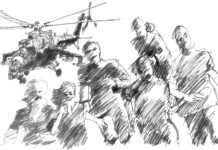 The digital-advertising tsunami that has long been forecast is coming ashore full-force in 2018.
The digital-advertising tsunami that has long been forecast is coming ashore full-force in 2018.
Who would have thought a decade ago that the digital-advertising spend in the Seattle market would top 55% by the end of 2017 and increase to nearly 60% (58.5) by the end of 2018—while the spend on traditional TV/cable advertising is expected to decrease, from 5.4% to 4.7%, respectively.
The actual numbers for digital dollars are $2.5 billion in 2016, $2.8 billion last year and a forecast of $3.2 billion this coming year—a whopping growth of $700 million in that three-year span. By comparison, total TV/broadcast and cable revenues for those years are $564 million, $509 million and $539 million—a corresponding decline of $25 million over the three-year period.
Total ad-revenue growth in Seattle is forecast at $4.7 billion in 2018—an increase of $375,500 over 2017. But digital will grow by more than $386,000, accounting for all of the increase.
Latest statistics from AdAge reflect the same trend on the national level. In 2017, the percentage of annual spend on digital advertising topped that for TV for the first time (35.1% vs. 34.7%). This compares with 2000, when the figures were 3.8% and 33.4%, respectively—a dramatic shift to be sure.
As one wag suggested, if you’re in the business of creating or selling digital advertising, the year ahead looks full of promise. But if you’re in the business of creating or selling traditional advertising, it may be time to freshen up your resume and look at your options.
Before we look at the by-medium changes, here are a few other noteworthy digital-ad trends:
• The percentage of ads blocked by online users is expected to reach 30% by the end of 2018. (Ad blocking on mobile is problematic, so this number relates mostly to desktop and laptop computers.)
• The mobile-advertising platform—vs. desktop and laptop—is projected to carry 70% of all digital-ad sales by the end of 2018.
• In 2017, 95% of digital-ad growth came from search and social-media placements (primarily Facebook). Facebook placements in Seattle were $117 million, a figure larger than local out-of-home media placements, and growing.
BY-MEDIUM TRENDS
- Spot Television: Due to the Olympics and political spending, spot broadcast TV (linear) will be up in 2018. The average over three years (2016-2018), however, shows broadcast TV down 6.3%. Spot TV now accounts for just 5.4% of total ad revenues in Seattle—and 42% of that comes from placements from outside the market. Sales folks are hoping to see growth from what they call “over the top” advertising—digitalTV, if you will. Nationally, that platform has grown to $5 billion annually.
- Radio: Like virtually all local traditional mediums in Seattle, radio was down in 2017 by 4.5% and a projected 4.8% in 2018—or down 9.1% over the two years. But 80% of that revenue is being placed from within the market, and placements from outside the market are experiencing the largest percentagedeclines. As a side note, we’re beginning to see more station consolidation in the market—moves made by the corporate folks looking for cost reductions.
- Out-Of-Home: This is the one bright spot among the local mediums. It was up 3.6% in 2017 and is forecast to grow another 2.9% in 2018. Nearly 40% of local revenues are placed from outside the market. Placement from both inside and outside are showing similar growth percentages, in the range of 3%.
Digital: This media category is driving all the ad-revenue growth in Seattle—around 11% last year and this—with 62% placed by outside buyers. In 2017, digital revenue grew by $281,600, while the market grew $191,702, accounting for all the growth, and more. In 2018, digital is projected to grow another $387 million. As mentioned earlier, virtually all the current digital growth is accounted for by paid search and social media (Facebook). The exploding mobile platform is projected to account for 70% of digital-ad sales by the end of 2018.
Newspaper: Newspapers continue to lose ROP revenue—down 10% last year and projected to be down 10.8 this year. These figures exclude digital sales, where a great deal of newspaper-management attention is these days. Revenue loss is about equal from both local and outside buyers. It’s fairly apparent, based on turnover and reorganizations, that newspapers are cutting overhead and unprofitable revenue sources.
Direct Mail: It will be down about 3% for the 2016-2018 period. Revenue declines are being experienced fairly equally from buyers both inside and outside the market.
Cinema: In another bit of good news, cinema was up 6.6% in 2017 and is expected to be up another 1.7% in 2018. But some 73% of local cinema revenues come from outside the market. Local placements are forecast to be down a miniscule .02% in 2018.
CONCLUSION
Perhaps the best way to view what’s happening in media today is to think of all traditional mediums as staying relatively constant, with digital capturing whatever dollar growth is being generated—by them.
Importantly, digital advertisers have found that paid search and social media are giving them best return on investment, thus relegating display, newsletters and other digital channels to declining shares.
•
Dan Japhet is the principal of Strategic Media Alignment and a long-time columnist in the former print edition of MARKETING newspaper. His Media Monitor posts will appear here periodically, as developments warrant. You can reach him at sma1@japhetmedia.com.






